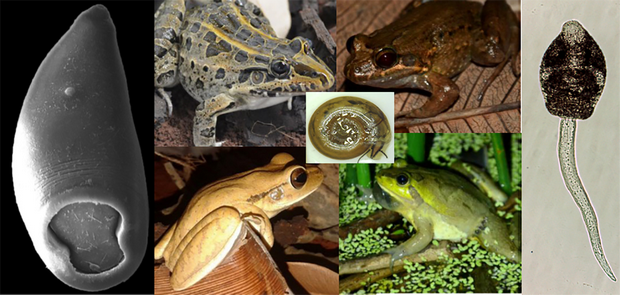Article contents
Exploring Neotropical anuran parasites: a morphological, life cycle and phylogenetic study of Catadiscus marinholutzi (Trematoda: Diplodiscidae)
Published online by Cambridge University Press: 17 February 2021
Abstract

Amphistome species belonging to the genus Catadiscus are poorly studied intestinal trematodes found primarily in Neotropical anurans. Herein, developmental stages of an amphistome species found during herpetological and malacological surveys in a temporary marsh pond from Brazil were subjected to morphological (light and scanning electron microscopy) and molecular analyses. Adult parasites recovered from anurans were identified as Catadiscus marinholutzi. Amphistome cercariae found in the planorbid snails Drepanotrema depressissimum and Drepanotrema lucidum from the same waterbody were used for experimental and molecular studies. Immature parasites, morphologically compatible with members of Catadiscus, were experimentally obtained in laboratory-reared tadpoles. Sequencing of a partial region of 28S rDNA gene of both adult and cercariae revealed 100% similarity between these developmental stages, confirming their conspecificity. Phylogenetic analyses were attempted for the first time to reveal the position of a species of Catadiscus in the superfamily Paramphistomoidea. Catadiscus marinholutzi falls in a virtual polytomy together with other paramphistomoids, which leaves its phylogenetic relationships within the group unclear. Moreover, the high genetic divergence to Diplodiscus spp. (10.06–10.84%) cast doubts on the placement of Catadiscus within Diplodiscidae. Hence the species composition of the Diplodiscidae should be re-evaluated in further studies using a broader spectrum of related taxa.
Keywords
- Type
- Research Article
- Information
- Copyright
- Copyright © The Author(s), 2021. Published by Cambridge University Press
References
- 3
- Cited by





